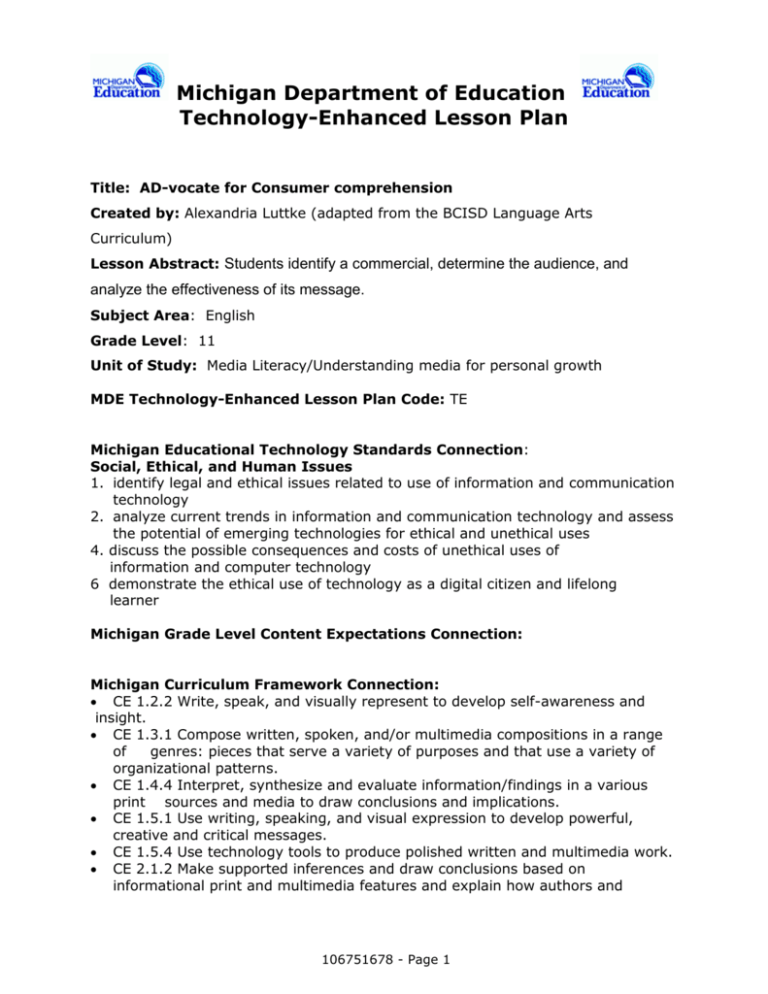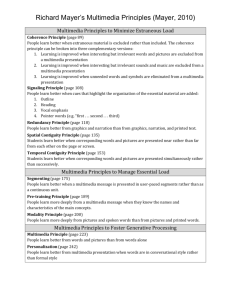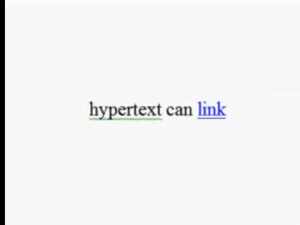AD-vocate for Consumer Comprehension
advertisement

Michigan Department of Education Technology-Enhanced Lesson Plan Title: AD-vocate for Consumer comprehension Created by: Alexandria Luttke (adapted from the BCISD Language Arts Curriculum) Lesson Abstract: Students identify a commercial, determine the audience, and analyze the effectiveness of its message. Subject Area: English Grade Level: 11 Unit of Study: Media Literacy/Understanding media for personal growth MDE Technology-Enhanced Lesson Plan Code: TE Michigan Educational Technology Standards Connection: Social, Ethical, and Human Issues 1. identify legal and ethical issues related to use of information and communication technology 2. analyze current trends in information and communication technology and assess the potential of emerging technologies for ethical and unethical uses 4. discuss the possible consequences and costs of unethical uses of information and computer technology 6 demonstrate the ethical use of technology as a digital citizen and lifelong learner Michigan Grade Level Content Expectations Connection: Michigan Curriculum Framework Connection: CE 1.2.2 Write, speak, and visually represent to develop self-awareness and insight. CE 1.3.1 Compose written, spoken, and/or multimedia compositions in a range of genres: pieces that serve a variety of purposes and that use a variety of organizational patterns. CE 1.4.4 Interpret, synthesize and evaluate information/findings in a various print sources and media to draw conclusions and implications. CE 1.5.1 Use writing, speaking, and visual expression to develop powerful, creative and critical messages. CE 1.5.4 Use technology tools to produce polished written and multimedia work. CE 2.1.2 Make supported inferences and draw conclusions based on informational print and multimedia features and explain how authors and 106751678 - Page 1 speakers use them to infer the organization of text and enhance understanding, convey meaning, and inspire or mislead audiences. CE 2.1.8 Recognize the conventions of visual and multimedia presentations (e.g., lighting, camera angle, special effects, color, and soundtrack) and how they carry or influence messages. CE 3.4.2 Understand that media and popular texts are produced within a social context and have economic, political, social, and aesthetic purposes. CE 3.4.3 Understand the ways people use media in their personal and public lives. CE 3.4.4 Understand how the commercial and political purposes of producers and publishers influence not only the nature of advertisements and the selection of media content, but the slant of news articles in newspapers, magazines, and the visual media. CE 4.2.1 Understand how languages and dialects are used to communicate effectively in different roles, under different circumstances, and among speakers of different speech communities (e.g., ethnic communities, social groups, professional organizations). CE 4.2.2 Understand the implications and potential consequences of language use (e.g., appropriate professional speech; sexist, racist, homophobic language). CE 4.2.3 Recognize and appreciate language variety, understand that all dialects are rule-governed, and respect the linguistic differences of other speech communities. CE 4.2.4 Understand the appropriate uses and implications of casual or informal versus professional language; understand, as well, the implications of language designed to control others and the detrimental effects of its use on targeted individuals or groups (e.g., propaganda, homophobic language, and racial, ethnic, or gender epithets). CE 4.2.5 Recognize language bias in one’s community, school, textbooks, the public press, and in one’s own use of language. Estimated time required to complete lesson or unit: Daily Time Allocation: 380 minutes Number of Days: 4 Instructional resources: Magazines that interest young people Information Power, Building Partnerships for Learning. Chicago, IL: American Library Association, 1998. The Ad and the Ego (Film). Parallax pictures. 2005. Law of the Student Press. Arlington, VA: Student Press Law Center, 1994. Media Ethics: Where Do You Draw the Line? Developed by educators at Newseum (703)284-3714; Published by Freedom Forum. Sivulka, Juliann. Soap, Sex, and Cigarettes: A Cultural History of American Advertising. Belmont, CA: Wadsworth Publishing, 1997. Shaver, Mary Alice. Make The Sale! How To Sell Media With Marketing. Chicago, IL: The Copy Workshop, 1995. Bendinger, Bruce, ed. Advertising: The Business of Brands. Chicago, IL: The Copy Workshop, 2001. 106751678 - Page 2 Sequence of Activities: Teacher explains through lecture and videos the impact that commercials are meant to have on their viewer. Teacher identifies with students the various themes in commercials (sex, youthfulness, health, family, consumerism, having better/being better). Students identify examples of commercials of each of the themes through reflection, videos and magazines. Students will reflect on the theme that is most presented to their age group and how they are affected by those commercials. Student selects and acquires a copy of their favorite TV commercial as one media form. (The teacher views for appropriateness). This could work well as a partner project as well, if a pair could agree on one commercial. Also, avoid duplication of the commercials for a variety of presentations. Student analyzes the commercial for theme, and uses examples from the commercial to prove how this theme is present. Student shares their commercial, its theme, and how the commercial is meant to affect the viewer to their classmates through a multimedia presentation. Commercial should be placed directly on the multimedia presentation. (Copyright permission must be acquired for commercial viewing for educational purposes) Assessments: Pre-Assessment: Teacher observation of interpretation and understanding of ideas and themes. Scoring Criteria: Not applicable Post-Assessment: Rubric for presentation Scoring Criteria: Exceptional An abundance of material clearly related to topic; points are clearly made and all evidence supports topic; varied use of Content materials Topic is clearly stated and developed; specific examples are appropriate and clearly develop topic; conclusion is clear; Coherence shows control; good and transitions; well Organization organized Very original presentation of material; uses the unexpected to full advantage; captures Creativity audience's attention Done Adequate Sufficient information that relates to topic; many good points made but there is an uneven balance and little variation There is a great deal Topic not clear; of information that is information not clearly included that does connected to the not support topic in topic any way Concept and ideas Most information are loosely presented in logical connected; lacks sequence; generally clear transitions; very well organized flow and but better transitions organization are needed choppy Some originality apparent; good variety and blending of materials/media Little or no variation; material presented with little originality or interpretation 106751678 - Page 3 Unacceptable Presentation is choppy and disjointed; does not flow; development of topic is vague; no apparent logical order of presentation Repetitive with little or no variety; insufficient use of multimedia Choppy use of multimedia Balanced use of materials; lacks multimedia materials; smooth transition properly used to Use of multimedia not from one medium to develop topic; use of as varied and not as another; multimedia media is varied and well connected to not clearly appropriate topic connected to topic Little or no multimedia used or ineffective use of multimedia; imbalance in use of Material materials. Too long or too short; ten or more minutes above or Length of Within two minutes of Within four minutes of Within six minutes of below the allotted Presentation allotted time +/– allotted time +/– allotted time +/– time Technology (hardware/software): http://www.parallaxpictures.org/AdEgo_bin/AE000.01.html (Web site for Ad and the Ego film) www.jea.org (Journalism Education Association web site) www.splc.org (Student Press Law Center web site Television with tv/dvd Computer connected to LCD Multimedia program Key Vocabulary: audience, analyze, effect, impact, identify, forms, commercial, message intent, media forms, effect Application Beyond School: As a teacher, it is important to remember to incorporate other forms of media into classroom projects. Dance, drama and artwork are also media forms. It may be interesting to view photos of famous artists work, videos of dance troupes, or watch a play. Ask students to respond to these forms of media in terms of their message to society or how they have influenced society. Another idea is that students create a commercial promoting a career choice. Teacher Reflection and Notes: 106751678 - Page 4








